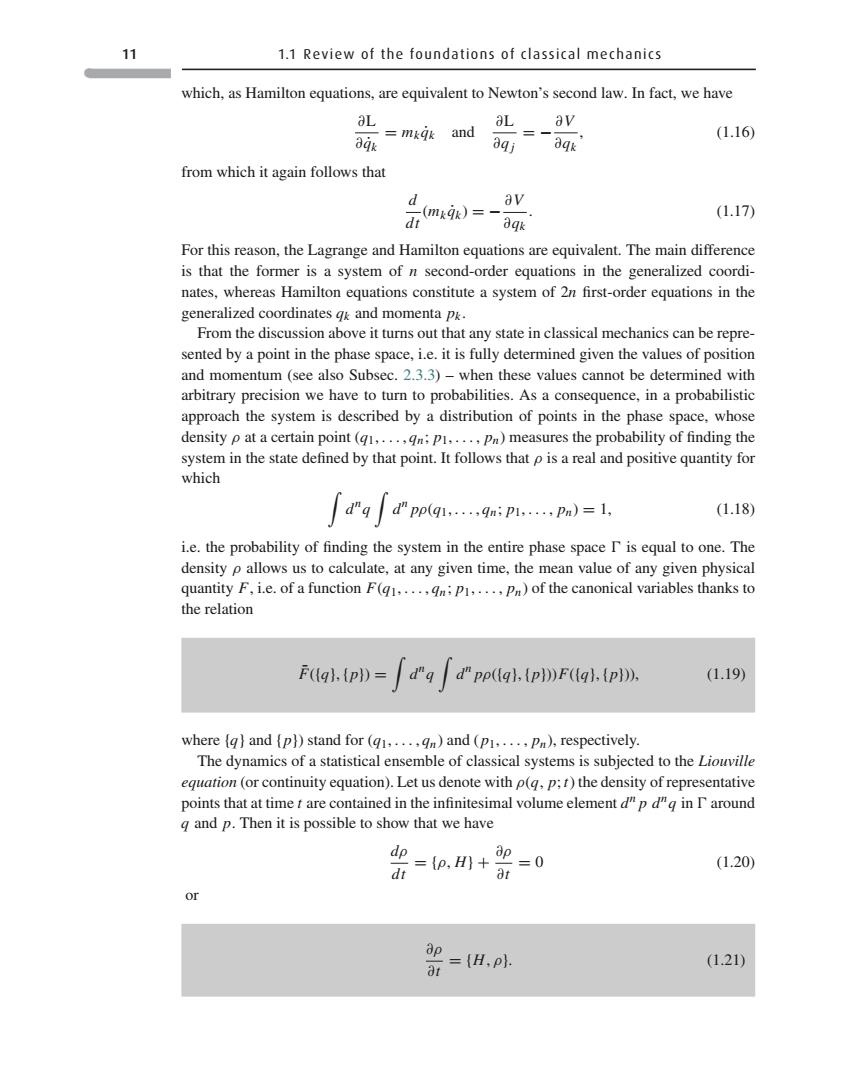正在加载图片...

11 1.1 Review of the foundations of classical mechanics which,as Hamilton equations,are equivalent to Newton's second law.In fact,we have aL 城=ms9kand av (1.16 from which it again follows that d av m=-8g (1.17 For this reason,the Lagrange and Hamilton equations are equivalent.The main difference is that the former is a system of n second-order equations in the generalized coordi- nates.whereas Hamilton equations constitute a system of 2n first-order equations in the From the discussion above it turns out that any state in classical mechanics can be repre sented by a point in the phase space,i.e.it is fully determined given the values of position and momentum (see also Subsec.2.3.3)-when these values cannot be determined with ence,in a probabilistic approach the system is described by a distribution of points in the phase space.whose density p at a certain point(,....:p.....p)measures the probability of finding the system in the state defined by that point It follows that o is a real and positive quantity for which d严q'pp(q1qPi…pm)=l (1.18) i.e.the probability of finding the system in the entire phase space is equal to one.The density p allows us to calculate,at any given time,the mean value of any given physical amjo("dd:ub...b)d uo F(q)(p))=da d"pp(lq)(pDF(lq)(p). (1.19) where (q)and (p))stand for(q1.....n)and (p1.....Pn).respectively. The dynamics of a statistical ensemble of classical systems is subjected to the Liouville equation(orcontinuity equation).Let us denote withp(p:)the density of representative points tha at at timet are contained in the infinitesimal volume elementp q and p.Then it is possible to show that we have 安=a+=0 (1.20) 器=H (1.21)11 1.1 Review o f the founda tions o f classical mechanics which, as Hamilton equations, are equivalent to Newton’s second law. In fact, we have ∂L ∂q˙k = mkq˙k and ∂L ∂q j = − ∂V ∂qk , (1.16) from which it again follows that d dt (mkq˙k ) = − ∂V ∂qk . (1.17) For this reason, the Lagrange and Hamilton equations are equivalent. The main difference is that the former is a system of n second-order equations in the generalized coordinates, whereas Hamilton equations constitute a system of 2n first-order equations in the generalized coordinates qk and momenta pk . From the discussion above it turns out that any state in classical mechanics can be represented by a point in the phase space, i.e. it is fully determined given the values of position and momentum (see also Subsec. 2.3.3) – when these values cannot be determined with arbitrary precision we have to turn to probabilities. As a consequence, in a probabilistic approach the system is described by a distribution of points in the phase space, whose density ρ at a certain point (q1, ... , qn; p1, ... , pn) measures the probability of finding the system in the state defined by that point. It follows that ρ is a real and positive quantity for which dnq dn pρ(q1, ... , qn; p1, ... , pn) = 1, (1.18) i.e. the probability of finding the system in the entire phase space is equal to one. The density ρ allows us to calculate, at any given time, the mean value of any given physical quantity F, i.e. of a function F(q1, ... , qn; p1, ... , pn) of the canonical variables thanks to the relation F¯({q},{p}) = dnq dn pρ({q},{p}))F({q},{p})), (1.19) where {q} and {p}) stand for (q1, ... , qn) and (p1, ... , pn), respectively. The dynamics of a statistical ensemble of classical systems is subjected to the Liouville equation (or continuity equation). Let us denote with ρ(q, p; t) the density of representative points that at time t are contained in the infinitesimal volume element dn p dnq in around q and p. Then it is possible to show that we have dρ dt = {ρ, H} + ∂ρ ∂t = 0 (1.20) or ∂ρ ∂t = {H, ρ}. (1.21)�